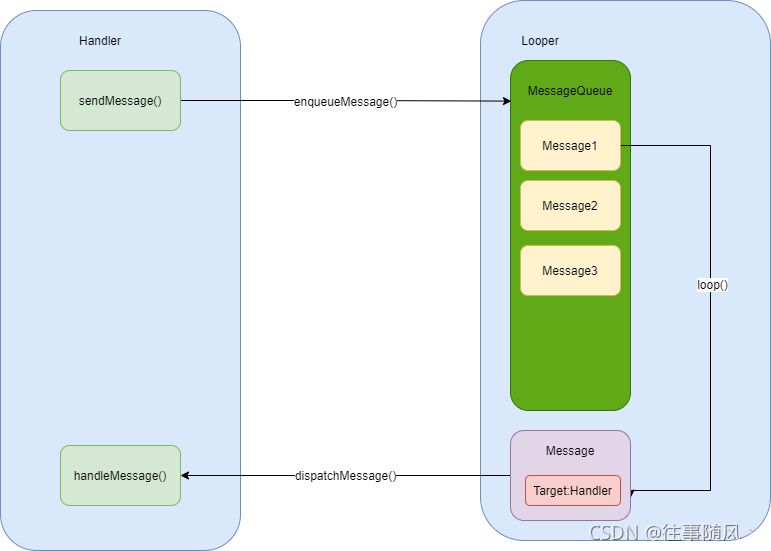1 消息机制
Android 消息机制本质上是 Handler 运行机制和 MessageQueue 以及Looper 工作过程,这三者所组成的一个整体运行机制。Android 消息循环机制如下图所示:

具体分为四大要素:
-
Message(消息):需要被传递的消息,消息分为硬件产生的消息(如按钮、触摸)和软件生成的消息。
-
MessageQueue(消息队列):负责消息的存储与管理,负责管理由 Handler 发送过来的Message。读取会自动删除消息,单链表维护,插入和删除上有优势。在其 next() 方法中会无限循环,不断判断是否有消息,有就返回这条消息并移除。
-
Handler(消息处理器):负责 Message 的发送及处理。主要向消息池发送各种消息事件(Handler.sendMessage())和处理相应消息事件(Handler.handleMessage()),按照先进先出执行,内部使用的是单链表的结构。
-
Looper(消息循环器):负责关联线程以及消息的分发,在该线程下从 MessageQueue获取 Message,分发给Handler,Looper创建的时候会创建一个 MessageQueue,调用loop()方法的时候消息循环开始,其中会不断调用messageQueue的next()方法,当有消息就处理,否则阻塞在messageQueue的next()方法中。当Looper的quit()被调用的时候会调用messageQueue的quit(),此时next()会返回null,然后loop()方法也就跟着退出。
整个消息的循环流程还是比较清晰的:
-
Handler 通过 sendMessage() 发送消息 Message 到消息队列 MessageQueue,MessageQueue 负责消息的存储与管理。
-
Looper 通过loop() 不断获取 Message,并将 Message 交给对应的 target handler 来处理。
-
target handler 调用自身的 handleMessage() 方法来处理 Message。
2 消息队列创建
消息机制中有一个很重要的部分就是消息队列 MessageQueue,主要有两个操作插入(enqueueMessage)和读取(next)。我们先来看看消息队列的创建。
public final class MessageQueue {
...
private long mPtr; // 地址值
private native static long nativeInit();
...
MessageQueue(boolean quitAllowed) {
mQuitAllowed = quitAllowed;
mPtr = nativeInit();//本地方法
}
}
//Looper 中创建 MessageQueue
public final class Looper {
private Looper(boolean quitAllowed) {
//创建消息队列
mQueue = new MessageQueue(quitAllowed);
//指向当前线程
mThread = Thread.currentThread();
}
}
我们可以看到调用本地方法完成初始化。
static jlong android_os_MessageQueue_nativeInit(JNIEnv* env, jclass clazz) {
//构建 NativeMessageQueue 对象
NativeMessageQueue* nativeMessageQueue = new NativeMessageQueue();
if (!nativeMessageQueue) {
jniThrowRuntimeException(env, "Unable to allocate native queue");
return 0;
}
nativeMessageQueue->incStrong(env);
//将对象的地址值转成 long 型传递给 Java 层
return reinterpret_cast<jlong>(nativeMessageQueue);
}
接下来我们看看 NativeMessageQueue。
NativeMessageQueue::NativeMessageQueue() : //继承 NativeMessageQueue
mPollEnv(NULL), mPollObj(NULL), mExceptionObj(NULL) {
//判断是否为当前线程创建过了 Looper 对象
mLooper = Looper::getForThread();
if (mLooper == NULL) {
//创建 Looper 对象
mLooper = new Looper(false);
//为线程设置 Looper
Looper::setForThread(mLooper);
}
}
接下来看看如何构造 Looper。
Looper::Looper(bool allowNonCallbacks) :
mAllowNonCallbacks(allowNonCallbacks), mSendingMessage(false),
mResponseIndex(0), mNextMessageUptime(LLONG_MAX) {
int wakeFds[2];
//创建管道
int result = pipe(wakeFds);
LOG_ALWAYS_FATAL_IF(result != 0, "Could not create wake pipe. errno=%d", errno);
//读端文件描述符
mWakeReadPipeFd = wakeFds[0];
//写端文件描述符
mWakeWritePipeFd = wakeFds[1];
...
//创建 epoll 实例,将它的文件描述符保存在变量 mEpollFd 中
mEpollFd = epoll_create(EPOLL_SIZE_HINT);
LOG_ALWAYS_FATAL_IF(mEpollFd < 0, "Could not create epoll instance. errno=%d", errno);
struct epoll_event eventItem;
memset(& eventItem, 0, sizeof(epoll_event)); // zero out unused members of data field union
eventItem.events = EPOLLIN;
eventItem.data.fd = mWakeReadPipeFd;
//将管道读端描述符添加到 epoll 中,以便监听管道的写操作
result = epoll_ctl(mEpollFd, EPOLL_CTL_ADD, mWakeReadPipeFd, & eventItem);
LOG_ALWAYS_FATAL_IF(result != 0, "Could not add wake read pipe to epoll instance. errno=%d",
errno);
}
pipe、epoll 是 Linux 端的知识,这里简单解释一下。
-
管道(pipe)是一种最基本的 IPC 机制,作用于有血缘关系的进程之间,完成数据传递。
-
epoll:I/O多路复用,监听多个文件描述符的IO读写事件,是Linux内核为处理大批量文件描述符]而作了改进的poll。
3 消息的添加
我们通常会调用 handler 的 sendXXX() 或 postXXX() ,实际调用的 MessageQueue的enqueueMessage()方法,将消息插入到目标线程的消息队列中。
public final class MessageQueue {
boolean enqueueMessage(Message msg, long when) {
//每个消息都必须有个target handler
if (msg.target == null) {
throw new IllegalArgumentException("Message must have a target.");
}
//每个消息必须没有被使用
if (msg.isInUse()) {
throw new IllegalStateException(msg + " This message is already in use.");
}
//加锁
synchronized (this) {
//正在退出时,回收 Message,加入消息池。
if (mQuitting) {
...
//回收
msg.recycle();
return false;
}
msg.markInUse();
msg.when = when;
//mMessages表示当前需要处理的消息,队头的消息
Message p = mMessages;
boolean needWake;
if (p == null || when == 0 || when < p.when) {
// New head, wake up the event queue if blocked.
msg.next = p;
mMessages = msg;
needWake = mBlocked;
} else {
needWake = mBlocked && p.target == null && msg.isAsynchronous();
//将消息按照时间顺序插入到消息队列中
Message prev;
for (;;) {
prev = p;
p = p.next;
if (p == null || when < p.when) {
break;
}
if (needWake && p.isAsynchronous()) {
needWake = false;
}
}
msg.next = p; // invariant: p == prev.next
prev.next = msg;
}
//唤醒消息队列
if (needWake) {
nativeWake(mPtr);
}
}
return true;
}
}
3 消息循环
使用 Looper 来进行消息循环。
public class LooperThread extends Thread {
public Handler mHandler;
public void run() {
Looper.prepare();
mHandler = new Handler() {
public void handleMessage(Message msg) {
// process incoming messages here
}
};
Looper.loop();
}
//Looper.prepare()
private static void prepare(boolean quitAllowed) {
if (sThreadLocal.get() != null) {
throw new RuntimeException("Only one Looper may be created per thread");
}
sThreadLocal.set(new Looper(quitAllowed));
}
//创建主线程的Looper,在 ActivityThread 中使用,一般我们用不到
public static void prepareMainLooper() {
prepare(false);
synchronized (Looper.class) {
if (sMainLooper != null) {
throw new IllegalStateException("The main Looper has already been prepared.");
}
sMainLooper = myLooper();
}
}
Looper 使用 Looper.prepare() 方法来创建 Looper ,并且会使用 ThreadLocal 来实现与当前线程的绑定功能。然后 Looper.loop() 则不断从 MessageQueue 中获取 Message 。
public final class Looper {
...
public static void loop() {
//获取当前线程的 Looper
final Looper me = myLooper();
if (me == null) {
throw new RuntimeException("No Looper; Looper.prepare() wasn't called on this thread.");
}
//获取当前线程的消息队列
final MessageQueue queue = me.mQueue;
//确保当前线程处于本地进程中,Handler仅限于处于同一进程间的不同线程的通信。
Binder.clearCallingIdentity();
final long ident = Binder.clearCallingIdentity();
//进入loop主循环方法
for (;;) {
//不断的获取下一条消息,这个方法可能会被阻塞
Message msg = queue.next();
if (msg == null) {
return;
}
...
//处理消息
try {
msg.target.dispatchMessage(msg);
} finally {
...
}
...
//把message回收到消息池,复用。
msg.recycleUnchecked();
}
}
}
loop() 方法主要做了三件事:
-
调用 MessageQueue#next() 读取下一条 Message。
-
把 Message 分发给相应的 target,调用 dispatchMessage()。
-
再把分发的 Message 回收到消息池,以便重复利用。
5 消息的分发与处理
Looper.loop() 里面调用 next() 和 dispatchMessage() 对消息进行分发与处理。
5.1 消息的分发
public final class MessageQueue {
Message next() {
...
//注册到消息队列中空闲Handler个个数
int pendingIdleHandlerCount = -1;
//表示无消息到来时,当前线程需要进入睡眠状态的时间,
//0:不进入睡眠状态,-1:进入无限等待的睡眠状态,直到有人将它唤醒
int nextPollTimeoutMillis = 0;
for (;;) {
if (nextPollTimeoutMillis != 0) {
Binder.flushPendingCommands();
}
//阻塞操作,检测当前线程的消息队列中是否有消息需要处理
//里面也是 pipe / epoll
nativePollOnce(ptr, nextPollTimeoutMillis);
//查询下一条需要执行的消息
synchronized (this) {
final long now = SystemClock.uptimeMillis();
Message prevMsg = null;
//mMessages代表了当前线程需要处理的消息
Message msg = mMessages;
if (msg != null && msg.target == null) {
do {
prevMsg = msg;
msg = msg.next;
} while (msg != null && !msg.isAsynchronous());
}
if (msg != null) {
if (now < msg.when) {
//如果当前消息头是延时消息,比当前时间长的话,计算延时等待的时间并赋值
nextPollTimeoutMillis = (int) Math.min(msg.when - now, Integer.MAX_VALUE);
}
//如果消息的执行时间小于当前时间,则说明该消息需要立即执行,则将该消息返回,并从消息队列中
else {
mBlocked = false;
if (prevMsg != null) {
prevMsg.next = msg.next;
} else {
mMessages = msg.next;
}
msg.next = null;
...
return msg;
}
} else {
// 如果没有消息需要处理,将nextPollTimeoutMillis置为-1,让当前线程进入无限睡眠状态,直到被其他线程唤醒。
nextPollTimeoutMillis = -1;
}
//所有消息都已经被处理,准备退出。
if (mQuitting) {
dispose();
return null;
}
//pendingIdleHandlerCount:等待执行的Handler的数量
//mIdleHandlers:空闲 Handler 列表
if (pendingIdleHandlerCount < 0
&& (mMessages == null || now < mMessages.when)) {
pendingIdleHandlerCount = mIdleHandlers.size();
}
if (pendingIdleHandlerCount <= 0) {
//当没有空闲的Handler需要执行时进入阻塞状态
mBlocked = true;
continue;
}
//mPendingIdleHandler:IdleHandler数组
if (mPendingIdleHandlers == null) {
mPendingIdleHandlers = new IdleHandler[Math.max(pendingIdleHandlerCount, 4)];
}
mPendingIdleHandlers = mIdleHandlers.toArray(mPendingIdleHandlers);
}
//只有在第一次循环时,才会去执行idle handlers,执行完成后重置pendingIdleHandlerCount为0
for (int i = 0; i < pendingIdleHandlerCount; i++) {
final IdleHandler idler = mPendingIdleHandlers[i];
//释放 Handler 的引用
mPendingIdleHandlers[i] = null;
boolean keep = false;
try {
keep = idler.queueIdle();
} catch (Throwable t) {
Log.wtf(TAG, "IdleHandler threw exception", t);
}
if (!keep) {
synchronized (this) {
mIdleHandlers.remove(idler);
}
}
}
pendingIdleHandlerCount = 0;
nextPollTimeoutMillis = 0;
}
}
}
5.2 消息的处理
public class Handler {
...
public void dispatchMessage(Message msg) {
//当Message存在回调方法时,优先调用Message的回调方法message.callback.run()
if (msg.callback != null) {
//实际调用的就是message.callback.run();
handleCallback(msg);
} else {
//如果我们设置了Callback回调,优先调用Callback回调。
if (mCallback != null) {
if (mCallback.handleMessage(msg)) {
return;
}
}
//如果我们没有设置了Callback回调,则回调自身的Callback方法。
handleMessage(msg);
}
}
}
Looper.loop() 是个死循环,不断调用 MessageQueue.next() 获取 Message ,并调用msg.target.dispatchMessage(msg) 切换到 Handler 来分发消息,以此来完成消息的回调。




















 6万+
6万+

 被折叠的 条评论
为什么被折叠?
被折叠的 条评论
为什么被折叠?








